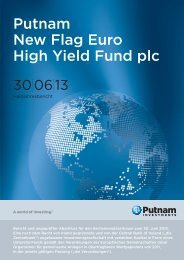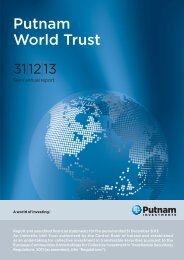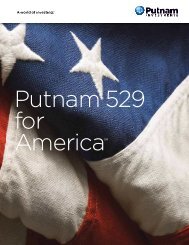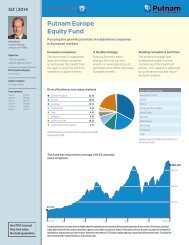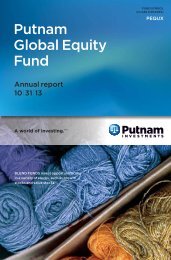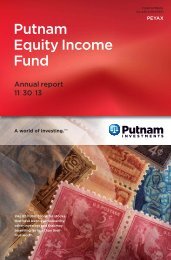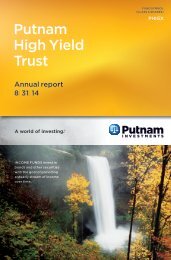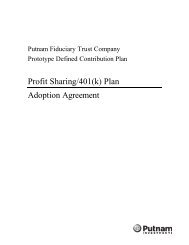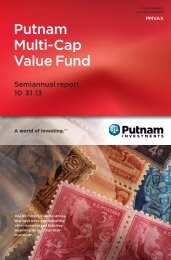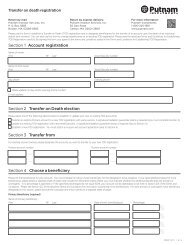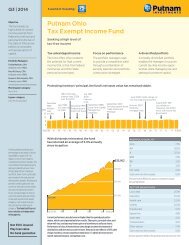Dynamic Risk Asset Allocation: Annual Report - Putnam Investments
Dynamic Risk Asset Allocation: Annual Report - Putnam Investments
Dynamic Risk Asset Allocation: Annual Report - Putnam Investments
Create successful ePaper yourself
Turn your PDF publications into a flip-book with our unique Google optimized e-Paper software.
OTC total return swap contracts outstanding, including their respective notional amounts at period end, if any, arelisted after the fund’s portfolio.Credit default contracts The fund entered into OTC and/or centrally cleared credit default contracts to hedge creditrisk, to hedge market risk and to gain exposure on individual names and/or baskets of securities.In OTC and centrally cleared credit default contracts, the protection buyer typically makes a periodic stream ofpayments to a counterparty, the protection seller, in exchange for the right to receive a contingent payment uponthe occurrence of a credit event on the reference obligation or all other equally ranked obligations of the referenceentity. Credit events are contract specific but may include bankruptcy, failure to pay, restructuring and obligationacceleration. For OTC credit default contracts, an upfront payment received by the fund is recorded as a liabilityon the fund’s books. An upfront payment made by the fund is recorded as an asset on the fund’s books. Centrallycleared credit default contracts provide the same rights to the protection buyer and seller except the paymentsbetween parties, including upfront premiums, are settled through a central clearing agent through variation marginpayments. Upfront and periodic payments received or paid by the fund for OTC and centrally cleared credit defaultcontracts are recorded as realized gains or losses at the reset date or close of the contract. The OTC and centrallycleared credit default contracts are marked to market daily based upon quotations from an independent pricingservice or market makers. Any change in value of OTC credit default contracts is recorded as an unrealized gainor loss. Daily fluctuations in the value of centrally cleared credit default contracts are recorded in variation marginon the Statement of assets and liabilities and recorded as unrealized gain or loss. Upon the occurrence of a creditevent, the difference between the par value and fair value of the reference obligation, net of any proportionalamount of the upfront payment, is recorded as a realized gain or loss.In addition to bearing the risk that the credit event will occur, the fund could be exposed to market risk due tounfavorable changes in interest rates or in the price of the underlying security or index or the possibility that thefund may be unable to close out its position at the same time or at the same price as if it had purchased the underlyingreference obligations. In certain circumstances, the fund may enter into offsetting OTC and centrally clearedcredit default contracts which would mitigate its risk of loss. <strong>Risk</strong>s of loss may exceed amounts recognized on theStatement of assets and liabilities. The fund’s maximum risk of loss from counterparty risk, either as the protectionseller or as the protection buyer, is the fair value of the contract. This risk may be mitigated for OTC credit defaultcontracts by having a master netting arrangement between the fund and the counterparty and for centrally clearedcredit default contracts through the daily exchange of variation margin. Counterparty risk is further mitigatedwith respect to centrally cleared credit default swap contracts due to the clearinghouse guarantee fund and otherresources that are available in the event of a clearing member default. Where the fund is a seller of protection, themaximum potential amount of future payments the fund may be required to make is equal to the notional amount.OTC and centrally cleared credit default contracts outstanding, including their respective notional amounts atperiod end, if any, are listed after the fund’s portfolio.Master agreements The fund is a party to ISDA (International Swaps and Derivatives Association, Inc.) MasterAgreements (Master Agreements) with certain counterparties that govern OTC derivative and foreign exchangecontracts entered into from time to time. The Master Agreements may contain provisions regarding, among otherthings, the parties’ general obligations, representations, agreements, collateral requirements, events of default andearly termination. With respect to certain counterparties, in accordance with the terms of the Master Agreements,collateral posted to the fund is held in a segregated account by the fund’s custodian and with respect to thoseamounts which can be sold or repledged, is presented in the fund’s portfolio.Collateral pledged by the fund is segregated by the fund’s custodian and identified in the fund’s portfolio. Collateralcan be in the form of cash or debt securities issued by the U.S. Government or related agencies or other securitiesas agreed to by the fund and the applicable counterparty. Collateral requirements are determined based on thefund’s net position with each counterparty.Termination events applicable to the fund may occur upon a decline in the fund’s net assets below a specifiedthreshold over a certain period of time. Termination events applicable to counterparties may occur upon a declinein the counterparty’s long-term and short-term credit ratings below a specified level. In each case, upon occurrence,the other party may elect to terminate early and cause settlement of all derivative and foreign exchangecontracts outstanding, including the payment of any losses and costs resulting from such early termination, asreasonably determined by the terminating party. Any decision by one or more of the fund’s counterparties to electearly termination could impact the fund’s future derivative activity.<strong>Dynamic</strong> <strong>Risk</strong> <strong>Allocation</strong> Fund75



